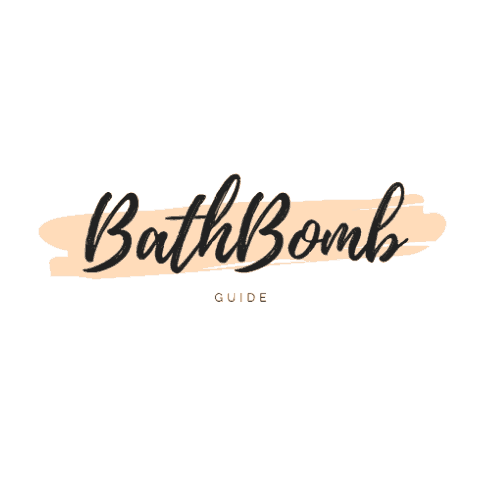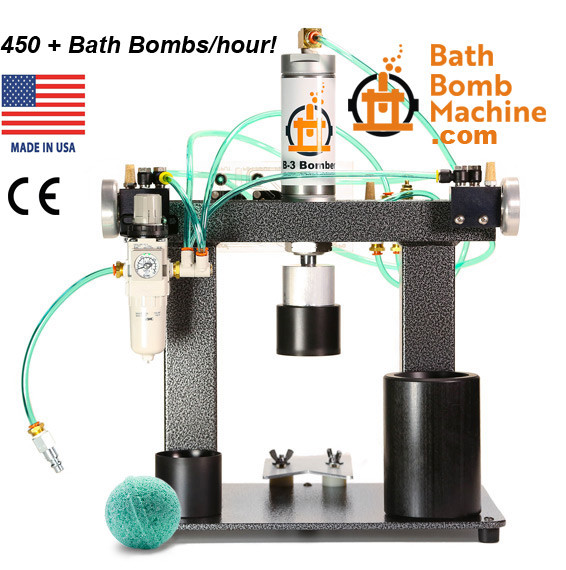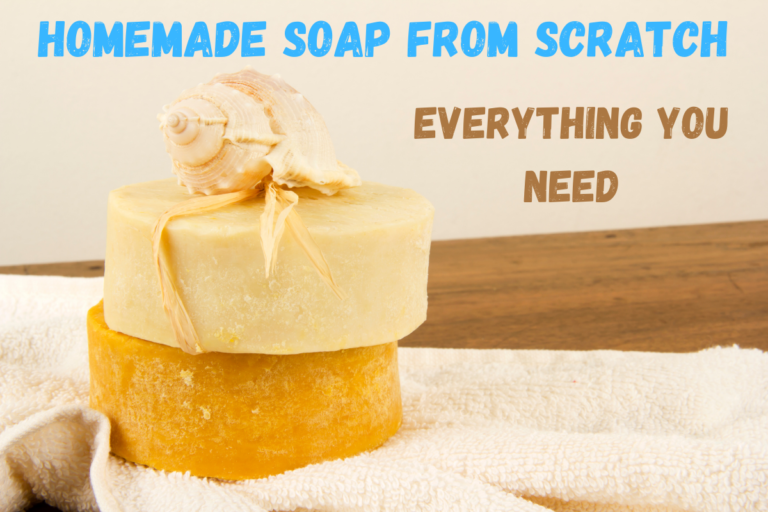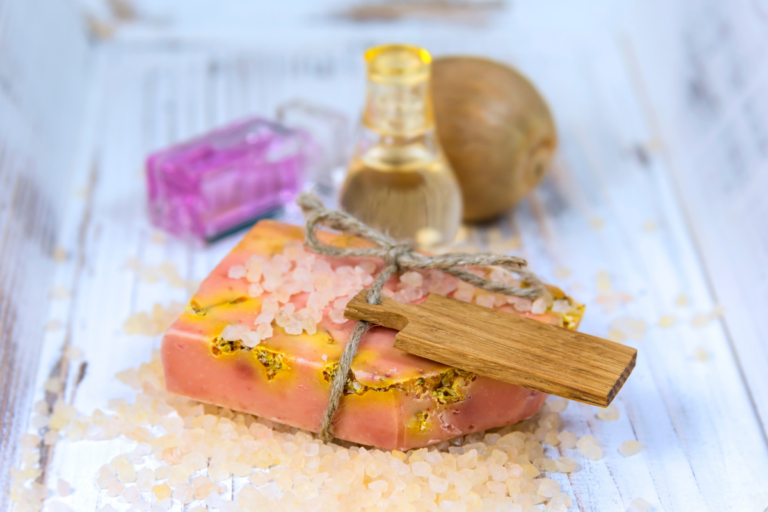Which Alcohol Should be Used in Soap Making? (Answers)
Isopropyl alcohol is one of the most useful tools for all types of soap making. As a binding agent in layered soaps, a bubble reducer, and a drying agent, ethyl and isopropyl alcohol are some of the handiest remedies to most of a soapmaker’s problems. But what for?
Alcohol is used in soap making to help remove the bubbles that form on melt and pour soaps, prevent soda ash from forming on the soap’s surface, join the layers of poured soaps, and make transparent soaps.
Alcohol can be used in different ways to make various soaps, such as layered soaps, melt-and-pour soaps, and transparent soaps. Alcohol can even make the suds from your soaps last longer and give your soaps a glossy sheen. Read on to find out which alcohol to use and when should you use it in soapmaking.
Should I Use Isopropyl or Ethyl Alcohol?
Both ethyl alcohol and isopropyl alcohol are useful for the same purpose in soapmaking. Ethyl alcohol is food-grade alcohol, while isopropyl alcohol is non-ingestible. Both are useful for popping bubbles, reducing soda ash, and binding layers when pouring layered soaps.
Generally, when you are pouring soaps with layers, ethanol will strengthen the joints between the layers. Isopropyl alcohol will pop the bubbles between your layers, but the joints will be weaker than those that have been primed with ethyl alcohol.
When making transparent soaps, you should use ethyl alcohol, although you can use isopropyl alcohol instead if you do not want to invest in ethyl alcohol. When making transparent soaps, ethyl alcohol will create a stronger soap, while isopropyl alcohol will leave a more noticeable smell and make a more flexible soap.
If you are worried about the alcohol’s smell overpowering your soaps, use a little bit less than usual. You should also avoid using denatured ethyl alcohol because its smell remains within your soap, and it is difficult to overpower. However, no matter how much alcohol you use, it will evaporate off your soap within days.
When Should I Use Alcohol in Soapmaking?
Alcohol is a necessary ingredient in melt-and-pour soaps.
If you are making hot process soaps or cold process soaps, you will not necessarily need alcohol, although alcohol can be used on hot or cold process soaps to reduce the appearance of soap ash and increase the amount of suds that you will get from your soap.
Popping Bubbles in Melt-and-Pour Soaps
Alcohol is notoriously useful for popping bubbles when you pour melt-and-pour soaps.
When you pour melt-and-pour soaps, bubbles can form within your soap, making it look more like swiss cheese than a bar of luxury soap. Alcohol can pop these bubbles before your soap solidifies.
When you pour your soaps, keep a bottle of either isopropyl alcohol or ethanol by your workspace.
Before pouring, prime your mold with alcohol. Pour the first layer of your soap, and then immediately spray it with alcohol. Spraying your soaps will bring all of the bubbles to the surface of your soap and pop them.
Using alcohol is imperative when creating soaps with inlaid soap pieces or multi-colored layers. Always spray alcohol between the layers to reduce bubbles and secure the joints between the layers.
Reducing Soda Ash
When making soap, a thin film of soda ash, or undissolved lye, can form on the surface of your soaps, giving them an ashy texture.
This soda ash forms when the lye in your soap mixture has not fully dissolved before pouring. Soda ash is not only unsightly, but it can burn skin, so it is essential to dissolve it before selling or using your soaps.
Alcohol can dissolve this soda ash, giving your soap a glossy, smooth surface.
To keep soda ash from forming on the surface of your soaps, spray your molds with alcohol before pouring your soap mixture into them. After you have removed your soaps from their molds, give them another spray with either isopropyl or ethyl alcohol to ensure that they will keep a smooth surface.
Extending the Suds
Are you disappointed with the lather of your homemade soaps? Adding alcohol can extend the life of your soap bubbles and make the lather a lot thicker.
Adding ethanol or isopropyl alcohol to your mixture will extend the suds that your soap makes.
For a rich, creamy lather, add ethanol or isopropyl alcohol to your oil mixture at 1-3% of the total oil weight. Doing so will increase the number of bubbles that your soap creates.
Making Transparent Glycerine Soaps
Ethanol is an ingredient in transparent soaps. Transparent soaps require glycerine, untinted oil, and ethanol in order to produce a crystal-clear soap. To make a transparent soap, you will need:
- Ethyl Alcohol
- Oils such as coconut, castor, and rice bran oil
- Liquid Glycerine
- Sugar
To make a transparent soap:
- Make a sugar solution. Combine 1 part water to 2 parts sugar in a pot and heat to a boil.
- Measure your base oils and melt them in a separate pot.
- Create your sodium hydroxide solution and let it sit until it is clear.
- Pour your sodium hydroxide solution into your oils and mix them thoroughly with a whisk or stick blender.
- Add in your glycerine and stir thoroughly again until a thick film forms at the surface.
- Once a film forms on the top of your sodium hydroxide, oil, and glycerine mixture, add your sugar solution.
- Mix all of your ingredients together again, and pour.
- Place your poured soaps into the freezer and let them solidify.
Transparent soaps are perfect for embedding or suspending herbs, colored soap chips and spirals, and other objects into them. Alcohol is another tool that will ensure that your items are embedded in the soap correctly.
Suspending Herbs and Soap Pieces in Your Soaps
Alcohol can also be useful in suspending and embedding objects such as herbs, objects, and soap chips in your soap. To suspend things in your soaps:
- Prepare your soap mixture as usual.
- Pour a shallow layer into your soap molds, and spray with alcohol.
- Add the herbs, soap shavings, or other items that you want to suspend in your soap.
- Spray another level of alcohol in your mold.
- Pour another layer of soap, and spray with alcohol again.
- Repeat the pouring and spraying process until the mold is full.
- Cool and allow your soaps to solidify as usual.
Cleaning Up Your Soapmaking Space
The mess from soapmaking can be hard to clean, especially considering that you are making soap. Because soap is oily, it can stubbornly stick to countertops, cooking utensils, and molds. Alcohol is the best agent to clean up soapmaking messes since the alcohol dissolves the oils that make soap.
To prevent soap from sticking to your soap molds, spray them with alcohol before pouring your soaps. This will prevent your soaps from sticking to the mold, and it will make cleanup a lot easier.
Clean all counters, utensils, and dishes you used while making your soap with a spritz of alcohol before you go in with more soap. This will loosen up any stubborn clumps and neutralize any remnants of lye in your kitchen.
Conclusion
Alcohol can be used for many purposes in soapmaking, making it necessary for any soap maker. Ethyl and isopropyl alcohol have different purposes and benefits. Ethyl alcohol is best for popping bubbles in melt-and-pour soaps and making transparent soaps. Isopropyl alcohol is better at reducing soda ash, increasing the number of bubbles that your soap produces, and suspending herbs and soap chips in your soap.
Alcohol really is a useful tool in many different types of soapmaking, and hopefully, it will help you in your own soapmaking practices.
A Few Essentials and My Favorite Things
Because there are so many places to find and so much information to go through on-site, I thought I would bring a few of the most popular items from the site, and my favorite products all in one place so you can check them out easily.
Bath Bomb Maker
Take your bath bomb making to the next level and go from making 10 in a day to 10 in just a few minutes. The B-3 Bath Bomb Machine is the best on the market and helps turn around orders in super quick time
Bath Bombs for Men
Go figure this is the most popular area of the website, guys love bath bombs or you ladies like buying them for him.
Dehumidifier
The biggest problem often for bath bomb makers or soap makers is the humidity. This 4500 Sq Ft model from Amazon, is more than big enough for most bath bomb makers and can be used for the entire basement or anywhere else in the house.
Scales
The one thing you will need if you are making bath bombs, shower steamer or homemade soap is some good and reliable digital scales so your measurements can be as precise as digitally possible. These Kitchen Scales are from Amazon’s Choice, and they are mine too, as they are solid, reliable and inexpensive.
I hope you find everything you have come to Bath Bomb Guide to look for and enjoy the site.
My Favourite Bath Bombs
This is my favorite bath treat set from Amazon which includes a bath bomb, salts, and more, It is the perfect all-round package, all of which are included here on the bath bomb guide site, in the various sections
Turkish Cotton Towels
My towels are one of my favorite things. A soft, fluffy Turkish bath sheet to wrap up in is the best compliment to a bath or shower. Sometimes I just take it out of the cupboard and wrap up on the couch watching TV! Being Turkish cotton they last really well.





